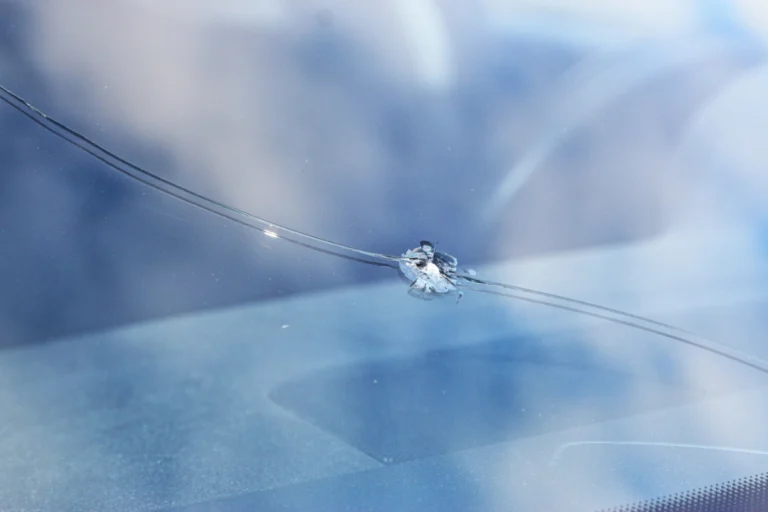Small Crack on Windshield Repair | A Comprehensive Guide
Small crack on windshield repair is crucial for maintaining the structural integrity and safety of your vehicle. Even small cracks can compromise the strength of the windshield and increase the risk of further damage or even shattering in the event of an accident. Therefore, it is essential to address these cracks promptly to prevent them from worsening over time. When it comes to repairing small cracks on windshields, there are various methods and costs involved.
Small Cracks on Windshields

Small cracks and chips on windshields can occur due to various factors, primarily related to external impacts or stress on the glass. One common way they occur is when small rocks or debris get kicked up by other vehicles on the road and collide with the windshield. This impact can result in a chip or crack, depending on the force and angle of impact. Additionally, temperature changes, such as sudden fluctuations or extreme heat, can also contribute to the formation of cracks by putting stress on the glass.
There are several common causes of small cracks on windshields, including:
Road debris: Rocks, gravel, and other debris on the road can be propelled towards your windshield by other vehicles, leading to chips and cracks upon impact.
Temperature changes: Extreme temperature changes, such as rapid heating or cooling, can cause the glass to expand or contract, increasing the likelihood of cracks forming.
Stress on the glass: Any excessive force or pressure on the windshield, such as slamming doors or objects hitting the glass, can weaken its integrity and result in cracks over time.
Structural weaknesses: Pre-existing flaws or imperfections in the glass can make it more susceptible to cracking, especially when subjected to external forces.
It’s important to address small cracks promptly to prevent further damage for several reasons:
Safety: Cracks can compromise the structural integrity of the windshield, reducing its ability to withstand impacts and increasing the risk of shattering in an accident.
Visibility: Cracks in the windshield can obstruct the driver’s view of the road, posing a safety hazard by reducing visibility and increasing the likelihood of accidents.
Legal compliance: In many jurisdictions, driving with a cracked windshield that obstructs the driver’s view is illegal and can result in fines or penalties. When it comes to your Tesla’s windshield or any other high-performance vehicle, swift repairs are essential. Don’t wait; prioritize immediate attention to keep your ride in top-notch condition.
Cost-effectiveness: Addressing small cracks early on can prevent them from spreading and requiring more extensive repairs or even windshield replacement, saving you time and money in the long run.
How to Fix Small Cracks & Chips in Your Windshield
DIY methods for repairing small cracks and chips
Materials needed for DIY repairs:
- Windshield repair kit (includes resin, curing strips, applicator, curing film)
- Microfiber cloth
- Razor blade or small knife
- Rubbing alcohol
- Safety gloves
Step-by-step guide on repairing small cracks using DIY kits:
Preparation:
- Park your vehicle in a shaded area to prevent the resin from drying too quickly.
- Clean the damaged area and the surrounding glass with rubbing alcohol and a microfiber cloth.
- Use a razor blade or small knife to remove any loose glass particles from the crack or chip.
Application of resin:
- Follow the instructions provided with your windshield repair kit.
- Apply a small amount of resin to the center of the damaged area using the applicator provided.
- Place a curing strip over the resin and apply gentle pressure to ensure it fills the crack completely.
Curing the resin:
- Place a curing film over the repair and expose it to direct sunlight or UV light as directed by the kit instructions.
- Allow the resin to cure for the specified time.
Finishing touches:
- Once the resin has cured, remove the curing film and strip.
- Use a razor blade or small knife to scrape away any excess resin from the surface of the windshield.
- Polish the repaired area with a clean microfiber cloth to ensure a smooth finish.
Professional windshield repair services
Overview of professional repair techniques:
- Professional repair technicians often use similar materials and techniques as DIY kits but have advanced tools and expertise.
- They may use specialized equipment such as vacuum injectors to ensure a more thorough repair.
- Professionals can also handle more extensive damage and provide warranties on their work.
Benefits of seeking professional help for small crack repairs:
- Higher likelihood of achieving a seamless repair with professional equipment and expertise.
- Saves time and effort, as professionals can quickly assess and repair the damage.
- Offers peace of mind with warranties and guarantees on the repair work.
- Can handle more complex or extensive damage that DIY kits may not be able to address effectively.
Factors to consider when choosing between DIY and professional repair options:
Cost: DIY kits are generally more affordable, but professional services may offer more comprehensive repairs for a higher cost.
Skill level: DIY repairs require some level of skill and precision, while professional technicians have specialized training and experience.
Extent of damage: Small cracks and chips may be suitable for DIY repairs, but larger or more complex damage may require professional attention.
Time: DIY repairs can be done at your convenience, but professional services often provide quicker turnaround times.
Warranty: Professional repairs typically come with warranties, providing added protection and assurance.
Small Crack on Windshield Repair Cost

Factors influencing the cost of repairing small cracks on windshields:
Size and severity of the crack: The larger or more severe the crack, the more materials and labor are required, thus increasing the cost.
Location of the crack: Cracks near the edges or corners of the windshield may require more intricate repair techniques, affecting the cost.
Type of vehicle: The make and model of the vehicle can influence the complexity of the repair process, which may impact the cost.
Type of repair method: Different repair methods, such as resin injection or DIY repair kits, can vary in cost.
Technician expertise: Experienced technicians may charge higher fees for their skills and expertise in repairing windshields.
Average cost range for DIY repair kits:
DIY repair kits for small cracks on windshields typically range from $10 to $30. These kits usually include resin, applicator tools, curing strips, and instructions for repairing minor damage.
Average cost range for professional windshield repair services:
Professional windshield repair services usually cost between $50 to $150 for repairing small cracks. The cost may vary depending on factors such as the severity of the damage, location, and the service provider’s pricing structure. If you want professional guidance then Reliable Auto Glass is best in business.
Tips for Preventing Small Cracks on Windshields
Maintenance tips to prevent small cracks and chips from occurring:
Avoid sudden temperature changes: Drastic changes in temperature can stress the glass, leading to cracks. Park your car in shaded areas during hot weather and avoid using hot water to defrost your windshield in winter.
Repair minor damage promptly: Even small chips or cracks can worsen over time, especially when exposed to vibrations from driving. Get them repaired promptly to prevent them from spreading.
Use high-quality cleaning products: Harsh chemicals and rough materials can scratch the windshield, weakening it and making it more prone to cracks. Use gentle cleaning products and soft cloths to clean your windshield.
Replace worn wiper blades: Old or damaged wiper blades can leave streaks or scratches on the windshield, which can weaken the glass over time. Replace them regularly to maintain clear visibility and prevent damage to the windshield.
Avoid slamming doors: Slamming your car doors can create vibrations that may contribute to small cracks forming on the windshield. Close doors gently to minimize stress on the glass.
Driving habits that can reduce the risk of windshield damage:
Maintain a safe following distance: Keeping a safe distance from the vehicle in front of you reduces the chances of debris kicked up by other vehicles hitting your windshield.
Avoid driving behind large trucks: Trucks often kick up debris from the road, increasing the risk of damage to your windshield. If possible, stay a safe distance behind trucks or change lanes to avoid driving directly behind them.
Watch out for construction zones: Construction zones are notorious for loose gravel and debris on the road. Drive cautiously and avoid following other vehicles too closely in these areas.
Slow down on rough roads: Rough roads can jostle your vehicle, increasing the likelihood of chips or cracks forming on the windshield. Reduce your speed to minimize the impact of bumps and potholes on the glass.
Be mindful of off-road driving: Off-road driving exposes your vehicle to a higher risk of debris and rocks hitting the windshield. Drive at a moderate speed and steer clear of areas with loose gravel or rocks.
Importance of regular windshield inspections for early detection of cracks:
Early detection saves money: Catching small cracks early allows for easier and less expensive repairs. Ignoring them can lead to larger cracks that may require windshield replacement, which is more costly.
Ensures safety: Cracks weaken the structural integrity of the windshield, compromising its ability to protect you in the event of an accident. Regular inspections help ensure that your windshield remains in good condition for optimal safety.
Prevents further damage: Small cracks can quickly worsen, especially when exposed to temperature changes and vibrations from driving. Regular inspections allow you to address minor damage before it spreads and becomes more difficult to repair.
Maintains visibility: Cracks and chips on the windshield can obstruct your view of the road, increasing the risk of accidents. By detecting and repairing damage early, you can maintain clear visibility and drive safely.
Compliance with regulations: In some regions, driving with a cracked windshield may be illegal and result in fines or penalties. Regular inspections help ensure that your windshield meets legal requirements for vehicle safety.
Conclusion
Addressing small cracks on windshields promptly through repair is essential for maintaining vehicle safety and preventing further damage. By following maintenance tips to prevent cracks, practicing safe driving habits, and conducting regular windshield inspections, drivers can ensure early detection of any damage. Repairing small cracks not only saves money but also maintains visibility, enhances safety, and ensures compliance with regulations. Feel free to contact us for any type of query or services like windshield repair.
FAQs
What Causes Small Cracks On Windshields?
Small cracks on windshields can be caused by various factors such as flying debris, temperature changes, and vehicle vibrations.
Can Small Cracks On Windshields Be Repaired?
Yes, small cracks on windshields can typically be repaired using specialized resin injection techniques.
How Do I Know If A Small Crack On My Windshield Can Be Repaired?
Generally, if the crack is smaller than a dollar bill and not in the driver’s line of sight, it can likely be repaired.
Is It Safe To Drive With A Small Crack On My Windshield?
It’s recommended to repair small cracks promptly to prevent them from spreading and compromising the structural integrity of the windshield.
How Long Does It Take To Repair A Small Crack On A Windshield?
Repairing a small crack on a windshield usually takes around 30 minutes to an hour, depending on the extent of the damage.
Will Repairing A Small Crack On My Windshield Make It Completely Disappear?
While repairs can significantly improve the appearance of the crack, it may still be slightly visible, especially depending on the location and severity of the damage.

